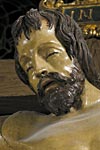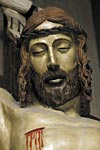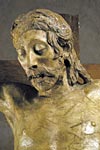A suggestive comparison between three wooden Crucifixes
from the Florentine 15th-century tradition is proposed
here: the Santa Croce one (1406-1408) by Donatello, the
Santa Maria Novella one (1410-1415) by Filippo
Brunelleschi and the Bosco ai Frati one from
Donatello’s circle (circa 1460), whose paternity is not
certain yet.



The comparison between the first two crucifixes from the important town basilicas, the Franciscan and the Dominican ones, was started by a 16th-century literary tradition later found in the pages of “The Lives” by Giorgio Vasari (1550 and 1568), according to which Brunelleschi sculpted his Crucifix as a friendly yet polemic answer to the one by Donatello, which he had judged as “a peasant” put “on a cross”.
The challenge has the unconventional tone of youth (Brunelleschi was about ten years older than Donatello), but, apart from this anecdote, the mutual comparison between the two artists certainly took place. In the first decade of the 15th century Donatello was still under the influence of the Gothic tradition, following Ghiberti, but with the impetuosity of a young man ready to follow new paths. Brunelleschi, a friend of his, who also sculpted in those years, with his Crucifix was putting forward a new Renaissance ideal of beauty filtered through reason.
The Bosco ai Frati Crucifix refers to the one above of noble and pained resignation by Brunelleschi; however, the gracile and fine body shows the influence of the mature Donatello of the 1450’s. This work was therefore carried out around 1460 and represents a kind of passage, both generational and artistic, between the one carved by Filippo for Santa Maria Novella and the one created by the young Michelangelo in 1494 for the Santo Spirito Church.



The comparison between the first two crucifixes from the important town basilicas, the Franciscan and the Dominican ones, was started by a 16th-century literary tradition later found in the pages of “The Lives” by Giorgio Vasari (1550 and 1568), according to which Brunelleschi sculpted his Crucifix as a friendly yet polemic answer to the one by Donatello, which he had judged as “a peasant” put “on a cross”.
The challenge has the unconventional tone of youth (Brunelleschi was about ten years older than Donatello), but, apart from this anecdote, the mutual comparison between the two artists certainly took place. In the first decade of the 15th century Donatello was still under the influence of the Gothic tradition, following Ghiberti, but with the impetuosity of a young man ready to follow new paths. Brunelleschi, a friend of his, who also sculpted in those years, with his Crucifix was putting forward a new Renaissance ideal of beauty filtered through reason.
The Bosco ai Frati Crucifix refers to the one above of noble and pained resignation by Brunelleschi; however, the gracile and fine body shows the influence of the mature Donatello of the 1450’s. This work was therefore carried out around 1460 and represents a kind of passage, both generational and artistic, between the one carved by Filippo for Santa Maria Novella and the one created by the young Michelangelo in 1494 for the Santo Spirito Church.
Donatello, Brunelleschi and the Man on the Cross
The Church and Convent of Bosco ai Frati
Donatello, Crucifix
Filippo Brunelleschi, Crucifix
Woodcarver, stylistically close to Donatello in his old age, and to Desiderio da Settignano, Crucifix